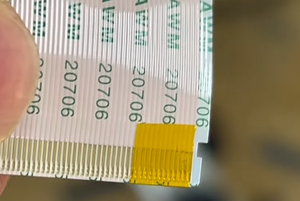The reason the "tape fix" works is because you are physically blocking certain signal lines from the T-con board to the LCD panel that are sending faulty data.
When one or more gate/source driver lines on the ribbon cable are shorted or degraded inside the panel, they can pull the entire display down, resulting in a black screen. By insulating those pins with tape, you stop the bad signals from reaching the panel. The rest of the panel can then operate, but you usually get side effects such as picture defects (stripes, color shifts, loss of sharpness).
Key points:
Replacing the T-con didn’t help → the T-con is fine.
Tape fix works → the fault lies in the LCD panel’s built-in driver circuits.
The mainboard is not the cause.
Permanent fix would mean replacing the entire LCD panel. Tape is only a workaround.
Here’s the breakdown of what is usually being blocked when you do a tape fix on an LCD panel ribbon:
1. Gate Driver (Row Scan) Signals
These control the vertical scanning of rows in the LCD.
If one gate driver line shorts, it can kill the entire panel. Blocking it stops the short from affecting the rest.
2. Source Driver (Column Data) Signals
These carry pixel data horizontally across the panel.
A faulty source line may inject bad data or noise. Blocking that pin removes the bad signal but reduces image quality (missing columns, stripes).
3. Clock / Sync Signals
These provide timing to coordinate pixel updates.
If one is corrupted, the display can go black. Blocking it can sometimes force the panel to run in a degraded mode.
4. VGH / VGL / VCOM (Panel Drive Voltages)
High- and low-level voltages that drive the TFT transistors.
If a short occurs here, it can completely disable the panel. Taping off that pin bypasses the shorted section.
crwdns2934105:0crwdne2934105:0
crwdns2934113:0crwdne2934113:0
crwdns2915270:0crwdne2915270:0
crwdns2889612:0crwdne2889612:0
0


 2
2 
 2
2  1
1